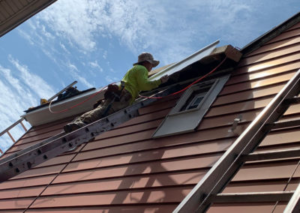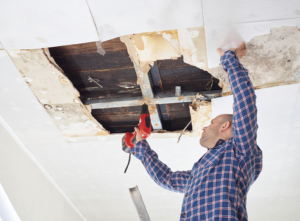There are many options when it comes to foundation repair, but not all methods are created equal. It is important to know which method to choose and when to choose it, so you can get your house back to its original state and prevent further damage.

Detecting foundation issues early can save you money and ensure the stability of your home.
If you’ve noticed cracks in your home’s foundation, it’s important to act fast. Depending on the severity of the crack, it may be structural or non-structural, and either way, you need to call a professional right away to assess the issue and provide appropriate solutions.
Some signs of a foundation problem are fairly obvious: doors or windows that no longer open or close easily, water intrusion in the basement following heavy rain, cracks developing in basement walls, or gaps forming between the foundation and trim work around windows and doors. But even if these signs don’t seem like big problems, it’s essential to have a professional inspect the area, as they could be an early indicator of bigger issues to come.
Several different methods exist for crack repair, with some offering a DIY-friendly solution for smaller issues and others requiring more extensive excavation and construction to stabilize the foundation. Masonry patching kits are available at hardware stores, featuring concrete cement, vinyl concrete, epoxies, or polyurethane foam, and are used to fill in cracks and prevent them from widening.
Steel piers, also known as push piers, are made of hollow steel pipes that are pushed into the ground under your home until they reach load-bearing soil. The steel piers then lift and support the foundation, relieving stress on the structure and stopping further movement or settlement.
Slab Foundation Repair is another common type of foundation repair, and involves strengthening and stabilizing the concrete slab upon which your house sits. This technique can include helical or steel piers, concrete underpinning, and adding or replacing pier stacks.
Waterproofing is a crucial component of many foundation repair techniques. Using coatings, membranes, or sealants, waterproofing creates a barrier against water penetration that can damage and deteriorate the foundation and other building materials. This can help prevent problems such as basement flooding, mold growth, and rot of wood beams that are used in a foundation. In some cases, waterproofing is a necessary step before performing more invasive repair methods.
Concrete Piers
Foundation repair contractors use concrete piers to help stabilize sagging, sinking, and tilting slab-on-grade foundations. They can also help with a wide range of problems that arise from poor soil conditions, like expansive clay, freezing temperatures, shifting soil subsidence, or even earthquakes.
These foundation repair techniques involve digging a hole below the home, installing the piers, and then pumping in a concrete slurry or dense foam to fill the space around them. This restores the original structural integrity of the slab, allowing it to support the structure above it. In many cases, this is a more affordable option for homeowners than replacing the entire slab foundation.
A popular method of repairing slab-on-grade foundations is to add a concrete pier to the structure and then pour a new section of foundation beneath it. This allows for more effective load distribution and helps to prevent future damage to the foundation. This is a popular choice for homeowners who want to keep their property’s value high and avoid costly repairs.
Concrete piers are highly durable and resist corrosion. They can withstand high loads and environmental pressures, and they are often less expensive than steel piers. They can come in a variety of shapes and sizes, and they can be constructed for specific load requirements or soil conditions.
Contractors can install a variety of different types of concrete piers, including helical and push piers. Helix piers are screw-shaped, and they can be drilled into the earth until they reach bedrock or another strong support point. Push piers are hollow, steel pipes that are pushed into the ground under the foundation to lift and stabilize it.
Regardless of the type of piers used, they can be inserted quickly and easily, making them an attractive solution for many homeowners who are dealing with foundation problems. The cost is usually less than a full replacement, and it typically takes no more than a day to complete this type of foundation repair.
If you’re dealing with foundation issues, it is important to contact a professional as soon as possible to receive prompt and effective repair services. Foundation repair can save your property from extensive damage and ensure it remains safe for years to come, and it may increase its resale value as well.
Steel Piers
A highly-effective method, steel piers transfer the weight of the foundation to stable soil layers or bedrock below the surface. This can be an excellent solution for addressing problems with your foundation that have resulted in a sinking, shifting or leaning house. They are also less prone to soil movement than concrete and helical piers. However, they do tend to be a more expensive option due to the cost of manufacturing and installation equipment.
To install these piers, our crew digs small holes in the ground near your foundation and then uses a hydraulic tool to push steel pipe segments vertically into the earth until they reach a solid load-bearing stratum below the surface. This process is typically faster and more effective than other foundation repair techniques.
The key to the success of this technique lies in its ability to transfer weight to a more stable subsurface than concrete or helical piers, which require a bracket system to support their loads. Unfortunately, this type of indirect support can lead to angular issues, compromising structural integrity and long-term stability.
Another advantage of steel piers is their greater depth tolerance. They can be driven up to 75 feet into the earth, making them ideal for dealing with expansive soils. They are also more resilient to shifts in the soil, preventing future damage and providing better long-term stability.
One of the primary disadvantages of steel piers is their tendency to rust over time. While this issue can be addressed by proper maintenance, it may be a concern for some property owners. Additionally, steel piers can be more difficult to install than other concrete repair methods, resulting in a longer project timeline.
For those looking for a more durable and affordable alternative to concrete piers, we recommend the Cable Lock(tm) ST Plus system. This technique combines the durability of steel with the gripping power of concrete to provide a high-quality, long-term foundation repair solution. To learn more about how this system can help your home or business, contact us today. We can answer any questions you have and determine if this is the best foundation repair method for your unique needs.
Epoxy Injections
While epoxy crack injection is an exceptional foundation repair technique, it may not be appropriate for all situations. If the soil shifts or erodes significantly, other methods such as slab jacking or helical piling may be required to stabilize and support your structure. However, for simpler cracks in your foundation or other concrete structure, an epoxy injection is a very effective and economical option.
Before applying the crack epoxy, all surfaces to receive paste-over should be thoroughly cleaned. All dirt should be brushed off the surface and any oil, grease or other contaminant should be removed using clean compressed air. If there is moisture trickling from the surface or around injection ports, this must be addressed before proceeding as it will impact the performance of the epoxy injection.
The injection process begins with the installation of injection ports in the area of the structural crack. Once the injection ports are in place, a mixture of epoxy resins is injected into the structural crack. A lower viscosity epoxy is used for small cracks and a higher viscosity epoxy is used for larger structural cracks.
As the epoxy penetrates the crack, it expands and fills it. This not only seals the crack but also reinforces the concrete structure to prevent further damage from occurring. When correctly executed, an epoxy injection can effectively weld the concrete structure together and restore the strength of the concrete that was lost through the crack.
Epoxy crack injection repairs are very time efficient and require minimal disruption to the surrounding environment, making them an ideal solution for both residential and commercial properties that need to minimize downtime during repair. Additionally, an epoxy crack injection is a very long-lasting solution that can greatly reduce the need for frequent and costly maintenance.
If you would like to learn more about our epoxy crack injection services, contact us for more information. We can help you decide which solution is the best choice for your unique situation. We can provide a detailed inspection and evaluation of your structural damage, recommend the best course of action and outline the cost-effectiveness of our services.






